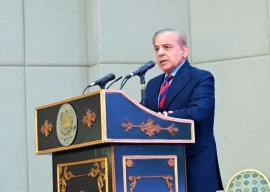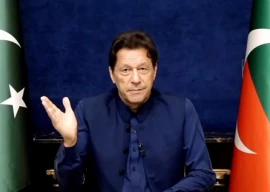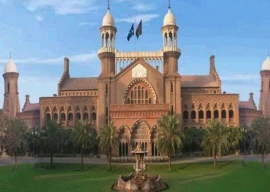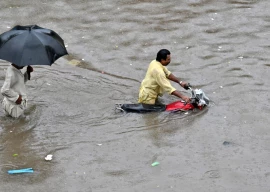
Making education a statutory fundamental right is not enough unless implementation steps are taken seriously. The situation merits a thorough understanding of the sector focusing on three main indicators: available resources, current enrolment and the number of out-of-school children, and quality. This analysis will explain how huge a task it is to provide free and compulsory education from the primary to matric level.
The Sindh government roughly spends 21 per cent of its budget on education. In 2013-14, it has kept Rs118 billion for education out of a Rs617 billion outlay. According to Sindh Education Information Management System’s 2011-12 data, there are 50,494 primary, elementary, secondary and higher secondary schools in 23 districts with a total enrolment of 4.33 million children. Of these schools, 91 per cent are primary schools claiming 73.6 per cent of the provincial education budget. This is the area where over 7,000 ghost and closed schools exist and teachers draw salaries without performing their duties.
This is a test of the Sindh government’s commitment towards its constitutional obligations. It needs to build new schools, hire additional teachers and incur other related expenses. All this has huge budgetary implications; the government has to increase the current budget by 100 per cent in order to achieve a target of 100 per cent enrolment at primary level by 2017-18. Considering resource constraints, this is unlikely to happen. So, what should be the strategy for resource mobilisation in order to accomplish 100 per cent enrolment? Two available opportunities are the involvement of the private sector and international donor agencies. Both sectors are already extending their help, though with reservations. The government must chalk out a clear policy of winning their confidence. At present, there is only the Public Private Partnership (PPP) Act, which can facilitate such involvement but even that is inadequate as it mainly deals with infrastructure projects in the province and does not mention ‘services’.
In addition to this Act, there is an adopt-a-school policy for engaging the private sector and individuals in improving low-performing public schools. The policy is implemented through the Sindh Education Foundation, a semi-autonomous organisation. There are a lot of lacunas in the policy, with school adopters having limited control over government teachers, curriculum etc. Realising these shortcomings, Sindh’s education and literacy department has started a process of review in consultation with relevant stakeholders. As a result, a first set of amendments to the PPP Act have been prepared by experts. The proposed amendments represent the needs of the education department only, so without taking input from other departments, possibilities are very low for it to be passed by the legislators.
Another challenge being faced by Sindh is the quality of the education. The findings of National Education Assessment System, Provincial Education Assessment System, Standard Achievement Test and others confirm apprehensions that public education is on the verge of collapse. The government must come up with a comprehensive policy for public-private partnership; otherwise, the aim of 100 per cent enrolment will remain unachieved.
Published in The Express Tribune, January 9th, 2014.
Like Opinion & Editorial on Facebook, follow @ETOpEd on Twitter to receive all updates on all our daily pieces.
COMMENTS (5)
Comments are moderated and generally will be posted if they are on-topic and not abusive.
For more information, please see our Comments FAQ




















1715142871-0/imfsalary-(1)1715142871-0-270x192.webp)





First of all to clarify, the Sindh PPP Act 2010 gives ample room to do services contract under management contract category and Health Department has already done one management contract under the same allowance at the NICH. The writer needs to do a lot more research and analysis as well - is it possible that this amendment in law issue has been raised by the same quarters who don't want things to move ahead and now they are starting an exercise which will be extremely cumbersome leading to more delays and stalling the process that is underway?
Mazhar Memon - PPPs are the way forward around the world - the only project of note completed during the last tenure of PPP Government in Sindh was Hyderabad Mirpurkhas Dual Carriageway; which was done under the PPP mode. The private sector might be a bit expensive but at the end of the day it delivers!
This public private partnership concept is a very perturbing. knowing the history of privatization it looks like it would be another scam to give away public funds to choice friends, contractors etc. Lot of money to be made here, as for education it will remain where it is or get worst, for the government it would be win-win situation because they could not be blamed after this change.
The author has not researched this topic thoroughly. The govt of India act 1935 resulted in the formation of the 'Central Advisory Board of Education' or CABE which was tasked with policy formation, planning and grants for education. The 1973 constitution with its concurrent list envisioned a similar role of the federal govt in education. And apart of curriculum and standards, all matters were left with the provinces. The nationalists do a disservice to their cause by twisting and mis-representing facts.
yes Zardari will come out clean becz when you have that much money you can buy judiciary & everybody else easily Absolutely
He probably bought them already & just doing a public stunt to show how nice & honest he is
The fact that 21% of Sindh's budget is a revelation for me, personally. I doubt if there is much to show for it, given that there are 7000 officially defined ghost schools... The number must be higher otherwise.
What is your opinion of the currently existing private schools in interior Sindh? I was educated at one in Ghotki and they seemed to be somewhat better than the local government school. Why shouldn't the government simply shutdown/sale out the operation of its schools and start paying subsidies to students to go to these private schools, while maintaining/regulating them to provide some set of standards. How far does the PPP go in this regard? Is there a draft somewhere on the web one can look at?